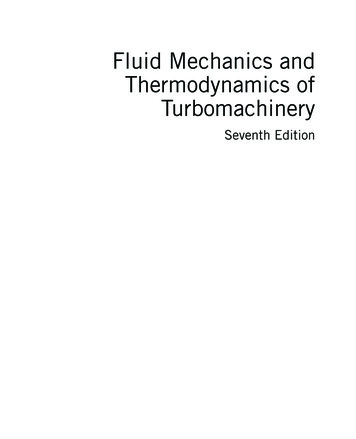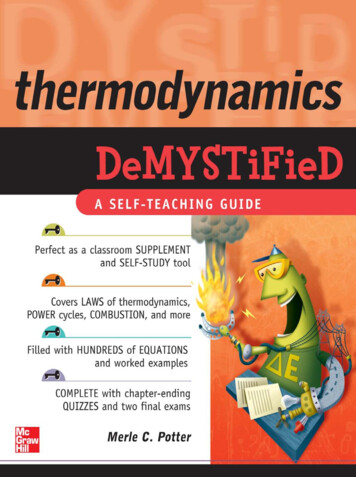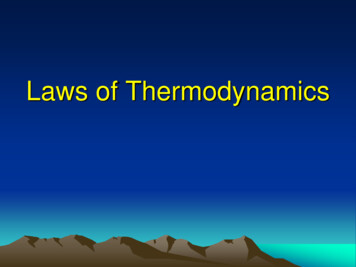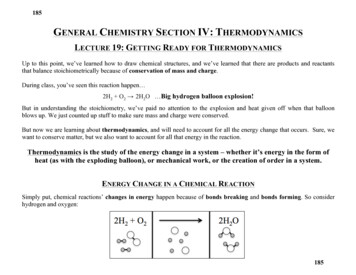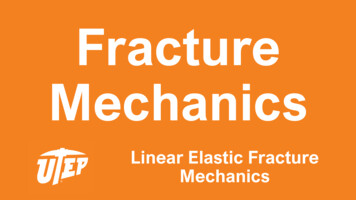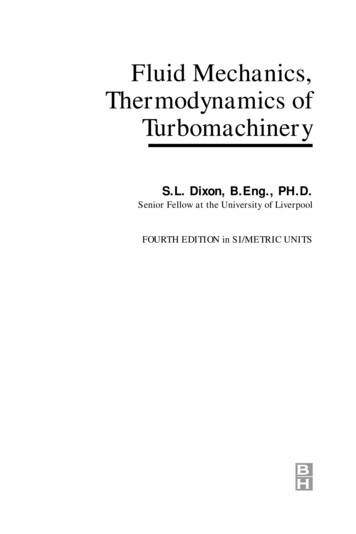
Transcription
Fluid Mechanics,Thermodynamics ofTurbomachineryS.L. Dixon, B.Eng., PH.D.Senior Fellow at the University of LiverpoolFOURTH EDITION in SI/METRIC UNITS
Fluid Mechanics,Thermodynamics ofTurbomachineryFOURTH EDITION in SI/METRIC UNITS
In memory ofAvril and baby Paul
Fluid Mechanics,Thermodynamics ofTurbomachineryS. L. Dixon, B.Eng., Ph.D.Senior Fellow at the University of LiverpoolFOURTH EDITION in SI/METRIC UNITS
Butterworth-HeinemannLinacre House, Jordan Hill, Oxford OX2 8DP225 Wildwood Avenue, Woburn, MA 01801-2041A division of Reed Educational and Professional Publishing LtdA member of the Reed Elsevier plc groupFirst published by Pergamon Press Ltd 1966Second edition 1975Third edition 1978Reprinted 1979, 1982 (twice), 1984, 1986, 1989, 1992, 1995Fourth edition 1998 S.L. Dixon 1978, 1998All rights reserved. No part of this publicationmay be reproduced in any material form (includingphotocopying or storing in any medium by electronicmeans and whether or not transiently or incidentallyto some other use of this publication) without thewritten permission of the copyright holder exceptin accordance with the provisions of the Copyright,Designs and Patents Act 1988 or under the terms of alicense issued by the Copyright Licensing Agency Ltd,90 Tottenham Court Road, London, England W1P 9HE.Applications for the copyright holder’s written permissionto reproduce any part of this publication should be addressedto the publishersBritish Library Cataloguing in Publication DataA catalogue record for this book is available from the British LibraryISBN 0 7506 7059 2Library of Congress Cataloguing in Publication DataA catalogue record for this book is available from the Library of CongressTypeset by Laser Words, Madras, IndiaPrinted and bound in
ContentsPREFACE TO FOURTH EDITIONPREFACE TO THIRD EDITIONACKNOWLEDGEMENTSLIST OF SYMBOLSixxixiiixv1. Introduction: Dimensional Analysis: SimilitudeDefinition of a turbomachine 1Units and dimensions 3Dimensional analysis and performance laws 4Incompressible fluid analysis 6Performance characteristics 7Variable geometry turbomachines 9Specific speed 10Cavitation 12Compressible gas flow relations 15Compressible fluid analysis 16The inherent unsteadiness of the flow within turbomachinesReferences 21Problems 221202. Basic Thermodynamics, Fluid Mechanics: Definitions of Efficiency 23Introduction 23The equation of continuity 23The first law of thermodynamics internal energy 24The momentum equation Newton’s second law of motionThe second law of thermodynamics entropy 29Definitions of efficiency 30Small stage or polytropic efficiency 35Nozzle efficiency 41Diffusers 43References 53Problems 5325
viContents3. Two-dimensional Cascades 55Introduction 55Cascade nomenclature 56Analysis of cascade forces 57Energy losses 59Lift and drag 59Circulation and lift 61Efficiency of a compressor cascade 62Performance of two-dimensional cascades 63The cascade wind tunnel 63Cascade test results 65Compressor cascade performance 68Turbine cascade performance 70Compressor cascade correlations 71Fan blade design (McKenzie) 80Turbine cascade correlation (Ainley) 81Comparison of the profile loss in a cascade and in a turbine stageOptimum space-chord ratio of turbine blades (Zweifel) 87References 88Problems 90864. Axial-flow Turbines: Two-dimensional Theory 93Introduction 93Velocity diagrams of the axial turbine stage 93Thermodynamics of the axial turbine stage 94Stage losses and efficiency 96Soderberg’s correlation 97Types of axial turbine design 99Stage reaction 101Diffusion within blade rows 103Choice of reaction and effect on efficiency 107Design point efficiency of a turbine stage 108Maximum total-to-static efficiency of a reversible turbine stageStresses in turbine rotor blades 114Turbine flow characteristics 120Flow characteristics of a multistage turbine 122The Wells turbine 124References 132Problems 1335. Axial-flow Compressors and Fans 137Introduction 137Two-dimensional analysis of the compressor stageVelocity diagrams of the compressor stage 140Thermodynamics of the compressor stage 141138112
Contents viiStage loss relationships and efficiency 142Reaction ratio 143Choice of reaction 143Stage loading 144Simplified off-design performance 145Stage pressure rise 147Pressure ratio of a multistage compressor 148Estimation of compressor stage efficiency 149Stall and surge phenomena in compressors 154Control of flow instabilities 159Axial-flow ducted fans 160Blade element theory 162Blade element efficiency 163Lift coefficient of a fan aerofoil 164References 165Problems 1666. Three-dimensional Flows in Axial TurbomachinesIntroduction 169Theory of radial equilibrium 169The indirect problem 171The direct problem 179Compressible flow through a fixed blade row 180Constant specific mass flow 181Off-design performance of a stage 183Free-vortex turbine stage 184Actuator disc approach 186Blade row interaction effects 190Computer-aided methods of solving the through-flow problemSecondary flows 193References 195Problems 1967. Centrifugal Pumps, Fans and Compressors 199Introduction 199Some definitions 200Theoretical analysis of a centrifugal compressor 202Inlet casing 203Impeller 203Conservation of rothalpy 204Diffuser 205Inlet velocity limitations 205Optimum design of a pump inlet 206Optimum design of a centrifugal compressor inlet 208Slip factor 213Head increase of a centrifugal pump 218191169
viii ContentsPerformance of centrifugal compressorsThe diffuser system 227Choking in a compressor stage 230References 232Problems 2338. Radial Flow Gas Turbines219236Introduction 236Types of inward flow radial turbine 237Thermodynamics of the 90 deg IFR turbine 239Basic design of the rotor 241Nominal design point efficiency 242Mach number relations 246Loss coefficients in 90 deg IFR turbines 247Optimum efficiency considerations 248Criterion for minimum number of blades 253Design considerations for rotor exit 256Incidence losses 260Significance and application of specific speed 263Optimum design selection of 90 deg IFR turbines 266Clearance and windage losses 269Pressure ratio limits of the 90 deg IFR turbine 269Cooled 90 deg IFR turbines 271References 272Problems 2739. Hydraulic Turbines277Introduction 277Hydraulic turbines 278The Pelton turbine 281Reaction turbines 290The Francis turbine 290The Kaplan turbine 296Effect of size on turbomachine efficiencyCavitation 301References 305Problems 306299Bibliography 309Appendix 1. Conversion of British and US Units to SI Units 310Appendix 2. Answers to Problems 311Index315
Preface to the Fourth EditionIt is now twenty years since the third edition of this book was published and inthat period many advances have been made to the art and science of turbomachinery design. Knowledge of the flow processes within turbomachines has increaseddramatically resulting in the appearance of new and innovative designs. Some ofthe long-standing, apparently intractable, problems such as surge and rotating stallhave begun to yield to new methods of control. New types of flow machine havemade their appearance (e.g. the Wells turbine and the axi-fuge compressor) andsome changes have been made to established design procedures. Much attentionis now being given to blade and flow passage design using computational fluiddynamics (CFD) and this must eventually bring forth further design and flow efficiency improvements. However, the fundamentals do not change and this book isstill concerned with the basics of the subject as well as looking at new ideas.The book was originally perceived as a text for students taking an Honours degreein engineering which included turbomachines as well as assisting those undertakingmore advanced postgraduate courses in the subject. The book was written for engineers rather than mathematicians. Much stress is laid on physical concepts ratherthan mathematics and the use of specialised mathematical techniques is mostly keptto a minimum. The book should continue to be of use to engineers in industryand technological establishments, especially as brief reviews are included on manyimportant aspects of turbomachinery giving pointers to more advanced sources ofinformation. For those looking towards the wider reaches of the subject area someinteresting reading is contained in the bibliography. It might be of interest to knowthat the third edition was published in four languages.A fairly large number of additions and extensions have been included in thebook from the new material mentioned as well as “tidying up” various sectionsno longer to my liking. Additions include some details of a new method of fanblade design, the determination of the design point efficiency of a turbine stage,sections on centrifugal stresses in turbine blades and blade cooling, control of flowinstabilities in axial-flow compressors, design of the Wells turbine, consideration ofrothalpy conservation in impellers (and rotors), defining and calculating the optimumefficiency of inward flow turbines and comparison with the nominal design. Anumber of extensions of existing topics have been included such as updating andextending the treatment and application of diffuser research, effect of prerotationof the flow in centrifugal compressors and the use of backward swept vanes ontheir performance, also changes in the design philosophy concerning the blading ofaxial-flow compressors. The original chapter on radial flow turbines has been splitinto two chapters; one dealing with radial gas turbines with some new extensionsand the other on hydraulic turbines. In a world striving for a ‘greener’ future it wasfelt that there would now be more than just a little interest in hydraulic turbines. Itis a subject that is usually included in many mechanical engineering courses. Thischapter includes a few new ideas which could be of some interest.
x Preface to the Fourth EditionA large number of illustrative examples have been included in the text and manynew problems have been added at the end of most chapters (answers are given at theend of the book)! It is planned to publish a new supplementary text called SolutionsManual, hopefully, shortly after this present text book is due to appear, giving thecomplete and detailed solutions of the unsolved problems.S. Lawrence Dixon
Preface to Third EditionSeveral modifications have been incorporated into the text in the light of recentadvances in some aspects of the subject. Further information on the interestingphenomenon of cavitation has been included and a new section on the optimumdesign of a pump inlet together with a worked example have been added whichtake into account recently published data on cavitation limitations. The chapter onthree-dimensional flows in axial turbomachines has been extended; in particular thesection concerning the constant specific mass flow design of a turbine nozzle hasbeen clarified and now includes the flow equations for a following rotor row. Someminor alterations on the definition of blade shapes were needed so I have taken theopportunity of including a simplified version of the parabolic arc camber line asused for some low camber blading.Despite careful proof reading a number of errors still managed to elude me in thesecond edition. I am most grateful to those readers who have detected errors andcommunicated with me about them.In order to assist the reader I have (at last) added a list of symbols used in thetext.S.L.D.xi
This is ablank page This is ablank pageThis is ablank page
AcknowledgementsThe author is indebted to a number of people and manufacturing organisations fortheir help and support; in particular the following are thanked:Professor W. A. Woods, formerly of Queen Mary College, University of Londonand a former colleague at the University of Liverpool for his encouragement of theidea of a fourth edition of this book as well as providing papers and suggestions forsome new items to be included. Professor F. A. Lyman of Syracuse University, NewYork and Professor J. Moore of Virginia Polytechnic Institute and State University,Virginia, for their helpful correspondence and ideas concerning the vexed questionof the conservation of rothalpy in turbomachines. Dr Y. R. Mayhew is thanked forsupplying me with generous amounts of material on units and dimensions and thelatest state of play on SI Units.Thanks are also given to the following organisations for providing me with illustrative material for use in the book, product information and, in one case, usefulbackground historical information:Sulzer Hydro of Zurich, Switzerland; Rolls-Royce of Derby, England; VoithHydro Inc., Pennsylvania; and Kvaerner Energy, Norway.Last, but by no means least, to my wife Rose, whose quiet patience and supportenabled this new edition to be prepared.
This is ablank page This is ablank pageThis is ablank page
List of SymbolsAabCfCL , CDCpCpiCvCX , CYccoDDeqDhE, eFcfgHHEHfHGHShIiK, kKNLlMmNNSNSPNSSnpareasonic velocity, position of maximum camberpassage width, maximum cambertangential force coefficientlift and drag coefficientsspecific heat at constant pressure, pressure coefficient, pressure risecoefficientideal pressure rise coefficientspecific heat at constant volumeaxial and tangential force coefficientsabsolute velocityspouting velocitydrag force, diameterequivalent diffusion ratiohydraulic mean diameterenergy, specific energycentrifugal force in bladeacceleration, friction factorgravitational accelerationhead, blade heighteffective headhead loss fue to frictiongross headnet positive suction head (NPSH)specific enthalpyrothalpyincidence angleconstantsnozzle velocity coefficientlift force, length of diffuser wallblade chord length, pipe lengthMach numbermass, molecular ‘weight’rotational speed, axial length of diffuserspecific speed (rev)power specific speed (rev)suction specific speed (rev)number of stages, polytropic indexpressure
xvi Fluid Mechanics, Thermodynamics of TurbomachinerypapvQqRReRHRorSsTtUuV, vW WwXx, y, zYYidYkYpYSZatmospheric pressurevapour pressureheat transfer, volume flow ratedryness fractionreaction, specific gas constantReynolds numberreheat factoruniversal gas constantradiusentropy, power ratioblade pitch, specific entropytemperaturetime, thicknessblade speed, internal energyspecific internal energyvolume, specific volumework transferspecific work transferrelative velocityaxial forceCartesian coordinate directionstangential force, actual tangential blade load per unit spanideal tangential blade load per unit spantip clearance loss coefficientprofile loss coefficientnet secondary loss coefficientnumber of blades, Ainley blade loading parameter ˇ absolute flow anglerelative flow anglecirculationratio of specific heatsdeviation anglefluid deflection angle, cooling effectivenessenthalpy loss coefficient, total pressure loss coefficientefficiencyminimum opening at cascade exitblade camber angle, wake momentum thicknessprofile loss coefficientdynamic viscositykinematic viscosity, blade stagger angle, velocity ratiodensityslip factor, solidityblade cavitation coefficientThoma’s coefficient, centrifugal stresstorqueυε b c
List of Symbols xvii S SP SSωωflow coefficient, velocity ratiostage loading factorspeed of rotation (rad/s)specific speed (rad)power specific speed (rad)suction specific speed (rad)vorticitystagnation pressure loss coefficientSubscriptsavcDehiidismNnopRrrelssstvx, y, z averagecompressor, criticaldiffuserexithydraulic, hubinlet, impelleridealisentropicmean, meridional, mechanical, materialnozzlenormal componentstagnation property, overallpolytropic, constant pressurereversible process, rotorradialrelativeisentropic, stall conditionstage isentropicturbine, tip, transversevelocitycartesian coordinate componentstangentialSuperscriptÐ0*time rate of changeaverageblade angle (as distinct from flow angle)nominal condition
This is ablank page This is ablank pageThis is ablank page
CHAPTER 1Introduction: DimensionalAnalysis: SimilitudeIf you have known one you have known all. (TERENCE, Phormio.)Definition of a turbomachineWe classify as turbomachines all those devices in which energy is transferredeither to, or from, a continuously flowing fluid by the dynamic action of one ormore moving blade rows. The word turbo or turbinis is of Latin origin and impliesthat which spins or whirls around. Essentially, a rotating blade row, a rotor or animpeller changes the stagnation enthalpy of the fluid moving through it by eitherdoing positive or negative work, depending upon the effect required of the machine.These enthalpy changes are intimately linked with the pressure changes occurringsimulataneously in the fluid.The definition of a turbomachine as stated above, is rather too general for thepurposes of this book as it embraces open turbomachines such as propellers, windturbines and unshrouded fans, all of which influence the state of a not readilyquantifiable flow of a fluid. The subject fluid mechanics, thermodynamics of turbomachinery, therefore, is limited to machines enclosed by a closely fitting casing orshroud through which a readily measurable quantity of fluid passes in unit time.The subject of open turbomachines is covered by the classic text of Glauert (1959)or by Duncan et al. (1970), the elementary treatment of propellers by general fluidmechanics textbooks such as Streeter and Wylie (1979) or Massey (1979), and theimportant, still developing subject of wind turbines, by Freris (1990).Two main categories of turbomachine are identified: firstly, those which absorbpower to increase the fluid pressure or head (ducted fans, compressors and pumps);secondly, those that produce power by expanding fluid to a lower pressure or head(hydraulic, steam and gas turbines). Figure 1.1 shows, in a simple diagrammaticform, a selection of the many different varieties of turbomachine encountered inpractice. The reason that so many different types of either pump (compressor) orturbine are in use is because of the almost infinite range of service requirements.Generally speaking, for a given set of operating requirements there is one type ofpump or turbine best suited to provide optimum conditions of operation. This pointis discussed more fully in the section of this chapter concerned with specific speed.Turbomachines are further categorised according to the nature of the flow paththrough the passages of the rotor. When the path of the through-flow is wholly or mainlyparallel to the axis of rotation, the device is termed an axial flow turbomachine (e.g.1
2Fluid Mechanics, Thermodynamics of TurbomachineryFIG. 1.1. Diagrammatic form of various types of turbomachine.Figure 1.1(a) and (e)). When the path of the through-flow is wholly or mainly in a planeperpendicular to the rotation axis, the device is termed a radial flow turbomachine (e.g.Figure 1.1(c)). More detailed sketches of radial flow machines are given in Figures 7.1,7.2, 8.2 and 8.3. Mixed flow turbomachines are widely used. The term mixed flow inthis context refers to the direction of the through-flow at rotor outlet when both radialand axial velocity components are present in significant amounts. Figure 1.1(b) showsa mixed flow pump and Figure 1.1(d) a mixed flow hydraulic turbine.One further category should be mentioned. All turbomachines can be classifiedas either impulse or reaction machines according to whether pressure changes are
Introduction: Dimensional Analysis: Similitude 3absent or present respectively in the flow through the rotor. In an impulse machineall the pressure change takes place in one or more nozzles, the fluid being directedonto the rotor. The Pelton wheel, Figure 1.1(f), is an example of an impulse turbine.The main purpose of this book is to examine, through the laws of fluid mechanicsand thermodynamics, the means by which the energy transfer is achieved in thechief types of turbomachine, together with the differing behaviour of individualtypes in operation. Methods of analysing the flow processes differ depending uponthe geometrical configuration of the machine, on whether the fluid can be regardedas incompressible or not, and whether the machine absorbs or produces work. Asfar as possible, a unified treatment is adopted so that machines having similarconfigurations and function are considered together.Units and dimensionsThe International System of Units, SI (le Système International d’Unités)is a unified self-consistent system of measurement units based on the MKS(metre kilogram second) system. It is a simple, logical system based upon decimalrelationships between units making it easy to use. The most recent detaileddescription of SI has been published in 1986 by HMSO. For an explanation ofthe relationship between, and use of, physical quantities, units and numerical valuessee Quantities, Units and Symbols, published by The Royal Society (1975) or referto ISO 31/0-1981.Great Britain was the first of the English-speaking countries to begin, in the1960s, the long process of abandoning the old Imperial System of Units in favourof the International System of Units, and was soon followed by Canada, Australia,New Zealand and South Africa. In the USA a ten year voluntary plan of conversionto SI units was commenced in 1971. In 1975 US President Ford signed the MetricConversion Act which coordinated the metrication of units, but did so withoutspecifying a schedule of conversion. Industries heavily involved in internationaltrade (cars, aircraft, food and drink) have, however, been quick to change to SI forobvious economic reasons, but others have been reluctant to change.SI has now become established as the only system of units used for teachingengineering in colleges, schools and universities in most industrialised countriesthroughout the world. The Imperial System was derived arbitrarily and has noconsistent numerical base, making it confusing and difficult to learn. In this bookall numerical problems involving units are performed in metric units as this is moreconvenient than attempting to use a mixture of the two systems. However, it isrecognised that some problems exist as a result of the conversion to SI units. Oneof these is that many valuable papers and texts written prior to 1969 contain datain the old system of units and would need converting to SI units. A brief summaryof the conversion factors between the more frequently used Imperial units and SIunits is given in Appendix 1 of this book.Some SI unitsThe SI basic units used in fluid mechanics and thermodynamics are the metre(m), kilogram (kg), second (s) and thermodynamic temperature (K). All the otherunits used in this book are derived from these basic units. The unit of force is the
4Fluid Mechanics, Thermodynamics of Turbomachinerynewton (N), defined as that force which, when applied to a mass of 1 kilogram,gives an acceleration to the mass of 1 m/s2 . The recommended unit of pressure isthe pascal (Pa) which is the pressure produced by a force of 1 newton uniformlydistributed over an area of 1 square metre. Several other units of pressure are in widespread use, however, foremost of these being the bar. Much basic data concerningproperties of substances (steam and gas tables, charts, etc.) have been prepared in SIunits with pressure given in bars and it is acknowledged that this alternative unit ofpressure will continue to be used for some time as a matter of expediency. It is notedthat 1 bar equals 105 Pa (i.e. 105 N/m2 ), roughly the pressure of the atmosphere atsea level, and is perhaps an inconveniently large unit for pressure in the field ofturbomachinery anyway! In this book the convenient size of the kilopascal (kPa) isfound to be the most useful multiple of the recommended unit and is extensivelyused in most calculations and examples.In SI the units of all forms of energy are the same as for work. The unit of energyis the joule (J) which is the work done when a force of 1 newton is displaced througha distance of 1 metre in the direction of the force, e.g. kinetic energy ( 21 mc2 ) has thedimensions kg ð m2 /s2 ; however, 1 kg D 1 N s2 /m from the definition of the newtongiven above. Hence, the units of kinetic energy must be Nm D J upon substitutingdimensions.The watt (W) is the unit of power; when 1 watt is applied for 1 second to a systemthe input of energy to that system is 1 joule (i.e. 1 J).The hertz (Hz) is the number of repetitions of a regular occurrence in 1 second.Instead of writing c/s for cycles/sec, Hz is used instead.The unit of thermodynamic temperature is the kelvin (K), written without the sign, and is the fraction 1/273.16 of the thermodynamic temperature of the triplepoint of water. The degree celsius ( C) is equal to the unit kelvin. Zero on thecelsius scale is the temperature of the ice point (273.15 K). Specific heat capacity,or simply specific heat, is expressed as J/kg K or as J/kg C.Dynamic viscosity, dimensions ML 1 T 1 , has the SI units of pascal seconds, i.e.kgN.s2M D 2 D Pa s.LTm.sm. sHydraulic engineers find it convenient to express pressure in terms of head of aliquid. The static pressure at any point in a liquid at rest is, relative to the pressureacting on the free surface, proportional to the vertical distance of the free surfaceabove that point. The head H is simply the height of a column of the liquid whichcan be supported by this pressure. If is the mass density (kg/m3 ) and g the localgravitational acceleration (m/s2 ), then the static pressure p (relative to atmosphericpressure) is p D gH, where H is in metres and p is in pascals (or N/m2 ). This isleft for the student to verify as a simple exercise.Dimensional analysis and performance lawsThe widest comprehension of the general behaviour of all turbomachines is,without doubt, obtained from dimensional analysis. This is the formal procedurewhereby the group of variables representing some physical situation is reduced
Introduction: Dimensional Analysis: Similitude 5into a smaller number of dimensionless groups. When the number of independent variables is not too great, dimensional analysis enables experimental relationsbetween variables to be found with the greatest economy of effort. Dimensionalanalysis applied to turbomachines has two further important uses: (a) predictionof a prototype’s performance from tests conducted on a scale model (similitude);(b) determination of the most suitable type of machine, on the basis of maximumefficiency, for a specified range of head, speed and flow rate. Several methods ofconstructing non-dimensional groups have been described by Douglas et al. (1995)and by Shames (1992) among other authors. The subject of dimensional analysis wasmade simple and much more interesting by Edward Taylor (1974) in his comprehensive account of the subject. It is assumed here that the basic techniques of formingnon-dimensional groups have already been acquired by the student.Adopting the simple approach of elementary thermodynamics, an imaginary envelope (called a control surface) of fixed shape, position and orientation is drawnaround the turbomachine (Figure 1.2). Across this boundary, fluid flows steadily,entering at station 1 and leaving at station 2. As well as the flow of fluid thereis a flow of work across the control surface, transmitted by the shaft either to, orfrom, the machine. For the present all details of the flow within the machine canbe ignored and only externally observed features such as shaft speed, flow rate,torque and change in fluid properties across the machine need be considered. To bespecific, let the turbomachine be a pump (although the analysis could apply to otherclasses of turbomachine) driven by an electric motor. The speed of rotation N, canbe adjusted by altering the current to the motor; the volume flow rate Q, can beindependently adjusted by means of a throttle valve. For fixed values of the set Qand N, all other variables such as torque , head H, are thereby established. Thechoice of Q and N as control variables is clearly arbitrary and any other pair ofindependent variables such as and H could equally well have been chosen. Theimportant point to recognise is, that there are for this pump, two control variables.If the fluid flowing is changed for another of different density , and viscosity , the performance of the machine will be affected. Note, also, that for a turbomachine handling compressible fluids, other fluid properties are important and arediscussed later.So far we have considered only one particular turbomachine, namely a pump ofa given size. To extend the range of this discussion, the effect of the geometricFIG. 1.2. Turbomachine considered as a control volume.
6Fluid Mechanics, Thermodynamics of Turbomachineryvariables on the performance must now be included. The size of machine is characterised by the impeller diameter D, and the shape can be expressed by a numberof length ratios, l1 /D, l2 /D, etc.Incompressible fluid analysisThe performance of a turbomachine can now be expressed in terms of the controlvariables, geometric variables and fluid properties. For the hydraulic pump it isconvenient to regard the net energy transfer gH, the efficiency , and power suppliedP, as dependent variables and to write the three functional relationships as l1 l2gH D f1 Q, N, D, , , , , . . . ,.1.1a/D D l1 l2.1.1b/ D f2 Q, N, D, , , , , . . . ,D D l1 l2.1.1c/P D f3 Q, N, D, , , , , . . . ,D DBy the procedure of dimensional analysis using the three primary dimensions, mass,length and time, or alternatively, using three of the independent variables we canform the dimensionless groups. The latter, more direct procedure, requires that thevariables selected, , N, D, do not of themselves form a dimensionless group. Theselection of , N, D as common factors avoids the appearance
2. Basic Thermodynamics, Fluid Mechanics: Definitions of Efficiency 23 Introduction 23 The equation of continuity 23 The first law of thermodynamics internal energy 24 The momentum equation Newton’s second law of motion 25 The second law of thermodynamics entropy 29 Definitio
